by Charles Thomson, co-founder of the Stuckists art group
In
1995, Damien Hirst defended his work with the rationale, "It's very easy
to say, 'I could have done that,' after someone's done it. But I did it.
You didn't. It didn't exist until I did it."
In 2000, he decided that doing it was not the justification after all:
"I don't think the hand of the artist is important on any level, because
you're trying to communicate an idea."
In 2006, the idea of the artist was not important on any level either:
"Lucky for me, when I went to art school we were a generation where we
didn't have any shame about stealing other people's ideas. You call it
a tribute".
In 2009, Anthony Haden-Guest interviewed Hirst: "Other artists have attacked
you for using their ideas. John LeKay said the skulls were his idea. John
Armleder … was doing spot paintings. And some say Walter Robinson did
the spin paintings first." Hirst's tribute was: "Fuck 'em all!"

Hirst's
career started In 1988 at the Freeze exhibition, when he painted
grids of spots with random colours. Thomas Downing, an American, painted
grids of spots with repeated colours in the 1960s. Gerhard Richter painted
grids of rectangles with random colours in 1966. John Armleder, a Swiss
artist, painted spots during the 1970s.
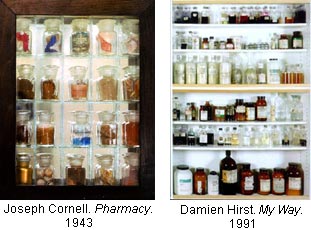
In
1989, Hirst starting making cabinets with bottles on shelves. In 1992,
he developed this into a room-size installation, called Pharmacy.
Joseph Cornell displayed a cabinet with bottles on shelves, called Pharmacy
in 1943.

In
1991, Hirst exhibited a preserved shark in a tank in Charles Saatchi's
art gallery in St John's Wood. Eddie Saunders exhibited a preserved shark
on a wall in his J.D. Electrical shop in the YBA heartland of Shoreditch
in 1989.

In 1992, Hirst moved to New York, where he met John LeKay, a 31 year old
British artist, resident in the city since 1981. Hirst was four years
younger, a celebrity in the UK, but still only four years out of college
and exhibiting in his first show (of twelve British artists) in the United
States. LeKay said Hirst "told me one time he was going to conquer America
like the Beatles."
LeKay
kept a journal. He recalls that Hirst visited his studio on several occasions
and showed considerable interest in his work. Hirst was working on "patch
paintings", which he abandoned after LeKay told him they were "shit" -
"The concept was brush marks on Francis Bacon's studio wall. Looked like
his grand mother made them."
They met frequently over the next few months, visiting each other's homes
and going to art openings, shows, parties and bars, sharing meals, getting
drunk together and playing badminton with a beach ball in the living room.
LeKay said Hirst was "a raging alcoholic and cocaine addict. He was always
snorting it. Drinking like a fish … He seemed to be really lost at times.
If he was not drinking or doing drugs, he seemed to be depressed. I gave
him some advice about this one time."
Contributing to Hirst's state of mind was the Turner Prize result in November
1992. LeKay said Hirst was "Angry about it. He seemed shocked he did not
win it."
LeKay, raised a Catholic like Hirst and described by Adrian Dannatt in
Flash Art as a "strung-out enfant terrible", was a kindred spirit,
if not a role model. LeKay recalled: "One time in the taxi going to Ashly
Bickerton's house, he said that he thought he was becoming me. Talking
and acting like me. It was very strange … I thought he was mentally ill
at that point or on coke."

Hirst
was sufficiently engaged to edit the sixth - and, as it turned out, final
- issue of LeKay's Pig (Politically incorrect geniuses) magazine,
enlisting Danny Moynihan, Marcus Harvey and Angus Fairhurst as contributors.
He also interviewed LeKay for the catalogue of LeKay's show in 1993 at
the Cohen Gallery, managed by Tanya Bonakdar, who had given Hirst his
first US solo show.
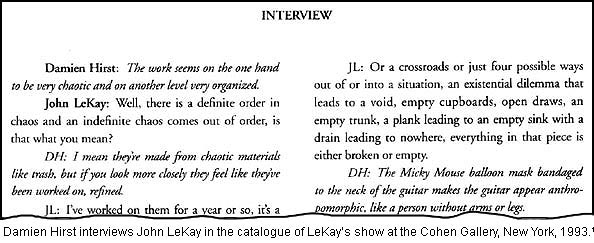
Hirst
mentioned that he was looking for a source of butterflies, and LeKay gave
him a spare copy of the Carolina Biological Supply Company Science
catalogue, which he had been using as a source of ideas. They reached
an agreement, said LeKay: "I put yellow stickers on the pages with the
skeletons, skulls, mannequins and resuscitation dolls I was working on.
He said he would stick to the animals and I would do the humans and he
was very happy."
Another time, LeKay showed Hirst a photo of one of his works, a split-open
sheep in a crucified posture. Hirst asked its date and - when told 1986
or 87 - became very quiet. "He got fidgety, bugged in the ride back in
the car to the city. Began making odd comments out of context. At the
time it made no sense. Then the next morning Tanya called me frantic,
telling me he smashed up the kitchen he was staying at. She said, ''what
the fuck did you say to him?' "
"I
said, 'Nothing. All I did was show him slides of my old work, the meat
pieces, to let him know I had done work like he was doing years before
him. To me it wasn't a big deal, but to him it was for some reason. If
I knew it would have upset him so much, I would never have shown the slides
to him.' She said, 'You have no idea how envious he is of you.' "
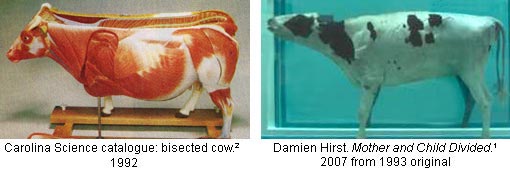
LeKay's gift of the Carolina Science catalogue manifested as a
dramatic development in Hirst's oeuvre within a few months. One of the
items illustrated was a model cow bisected lengthways. In the 1993 Venice
Bienniale, Hirst exhibited Mother and Child Divided, a cow
and a calf bisected lengthways.
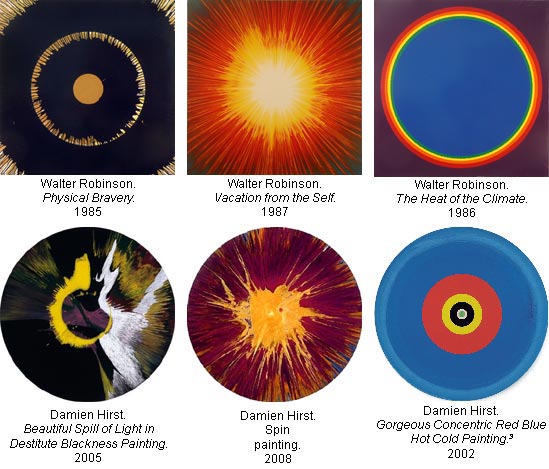
In
1995, Hirst started making "spin paintings", the titles of the first four
all beginning with the word "beautiful". Spin paintings - made by pouring
paint on a revolving surface - appeared in the 1950s as a popular novelty
activity and had also been made by artists. Swiss artist, Alfons Schilling,
and French artist, Annick Gendron made them in the 1960s. Walter Robinson,
an American artist, exhibited them during the 1980s. John LeKay developed
his own variant called "pour paintings" - which Hirst saw early in 1993
- by using a table which could tilt and swivel. LeKay says Hirst told
him they were "beautiful and sexy".

UK artist, Andy Shaw made spin paintings in 1993 and said that he talked
about them to Jay Jopling, who represented him and Hirst, a few months
before Hirst began to make his them. Hirst showed some in his 1996 show,
No Sense of Absolute Corruption, at the Gagosian Gallery in New
York. David Rimanelli in ArtForum said the only difference between
Robinson's and Hirst's was that some of Hirst's had motors to make them
rotate. LeKay said Hirst had paid particular attention to one of his "pour
paintings" that was "hanging on a toilet paper holder of a wall pierced
through its centre to make it rotate."
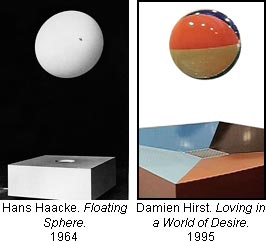
One
of Hirst's exhibits in the 1996 Gagosian show was an installation of a
ball held aloft in a jet of air. Hans Haacke made an installation of a
ball held aloft by a jet of air in 1964. Haacke used a white ball. Hirst
used a coloured ball.

Another Hirst exhibit was This Little Piggy Went to Market, a pig
split in two lengthways (in vitrines of formaldehyde). One of the pictures
in the Carolina Science catalogue given to Hirst by LeKay was an
anatomical model of a pig split in two lengthways. In 1984, Debby Davis
took a cast of half a pig cut open lengthways and made a fibreglass sculpture,
called Visible Pig. It was sold by Doug Milford of the Piezo Electric
gallery in January 1986 to Charles Saatchi, and auctioned at Christies,
New York, in November 1989.
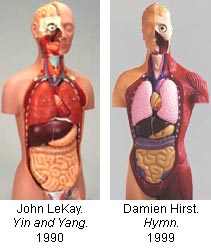
In
1999, Hirst made Hymn, an enlarged version of an anatomical torso
model from Humbrol. One of LeKay's found object works from 1990 was Yin
and Yang, an anatomical torso model from Carolina Science.
In 1999, celebrity chef, Marco Pierre White made a picture, Rising
Sun, to decorate his restaurant. He said that Hirst copied it a few
months later with a work called Butterflies on Mars and, according
to White, told him, "I'm the artist and you're the chef so everyone's
going to think you've copied me."
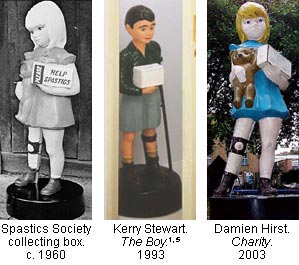
In
2003, Hirst made Charity, based on the model of a girl with a collecting
box displayed from the 1950s to the 1980s by The Spastics Society (now
renamed Scope). In 1993, Kerry Stewart, made The Boy from the Chemist
Is Here to See You, based on the Society's model of a boy with a collecting
box. Her work was part of Saatchi's Young British Artists shows
in the 1990s.
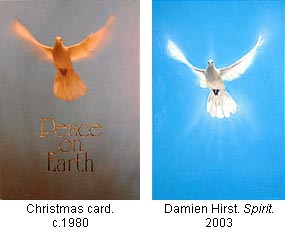
In
2003, Hirst painted Spirit, a dove in the sky with wings aloft. The same
image had been painted multiple times and exhibited for the previous four
years by Talaat Elshaabiny on the Bayswater Road. It was originally from
a 1980s Christmas card.
Hirst
exhibited artworks with butterflies in 1991, using whole butterflies scattered
on a painted surface. Lori Precious, a Los Angeles artist, started using
butterflies in 1992. She fixed the wings contiguously to create the effect
of stained glass windows. In 2003, Hirst started fixing butterfly wings
contiguously to create the effect of stained glass windows. Precious's
work in 2005 was titled with a literary quote from James Joyce. The titles
of Hirst's butterfly stained glass works in 2007 incorporated literary
quotes from Philip Larkin.
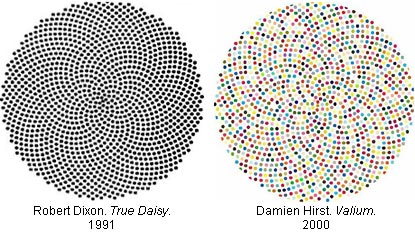
In
1991, True Daisy, a complex design of spiralling spots within a
circle by Robert Dixon, a mathematician and computer artist, was published
in The Penguin Dictionary of Curious and Interesting Geometry.
In 2003, Hirst contributed a design to The Guardian's colouring book for
children. Dixon said Hirst's design was "exactly the same" as his one.
Hirst's manager replied it was not copied from Dixon: Hirst had found
it in a book called The Penguin Dictionary of Curious and Interesting
Geometry.
In 2006, Dixon discovered that Hirst had also used True Daisy,
with the spots coloured in, for Valium, an edition of 500 prints
produced in 2000.

LeKay's
1986 work of a split-open crucified sheep, which had caused Hirst so much
upset, was titled This Is My Body, This Is My Blood. In 2005, Hirst
did a split-open crucified sheep, titled In the Name of the Father.
LeKay's was on a board. Hirst's was in a tank of formaldehyde.
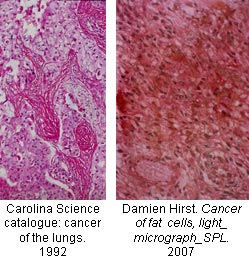
In
1993, LeKay made paintings based on images of cancer cells from the Carolina
Science catalogue. Hirst saw them. In 2007, in Beyond Belief
at the White Cube gallery in London, Hirst exhibited paintings based on
images of cancer cells from the Science Photo Library.
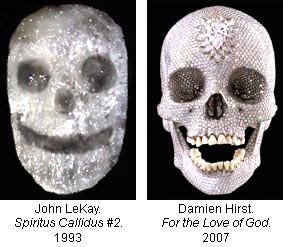
In
1993, LeKay produced a series of 25 skulls, some made out of paradichlorobenzene
and one made from soap covered with Swarovski crystals. Samples had been
in the Cohen Gallery. LeKay says he mentioned the idea of a skull covered
in diamonds to Bonakdar. In 2007, Hirst made a skull covered in diamonds.
LeKay used a title, Spiritus Callidus, a name for the devil. Hirst
called his For the Love of God.

In
2009, a year after he had divested himself of his stock of conceptual
and minimal art at the famous Sotheby's auction, Hirst announced that
conceptual and minimal art were "total dead ends" and that he "always
thought painting was the best thing to do".
http://www.stuckism.com/Hirst/StoleArt.html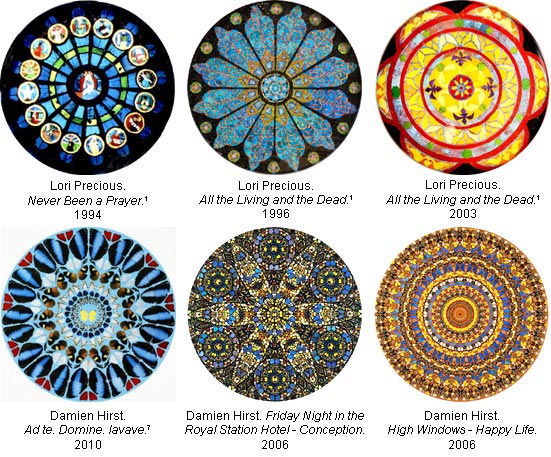
You might be interested in this: http://www.standard.co.uk/news/londoners-diary/melvyn-bragg-slips-into-the-great-damien-hirst-debate-9088218.html
ReplyDeleteDamien Hirst, an English artist and art collector is a member of Young British Artist. He dominated the art scene in 1990 in UK and named as the richest artist with wealth £215m. His creative work can be seen at the Ophear art gallery and definitely you will enjoy those. Get in to the site now and enjoy the art tour.
ReplyDelete